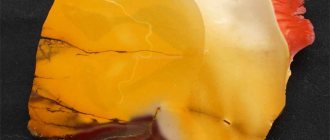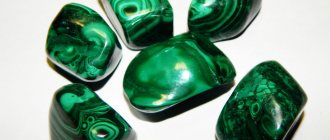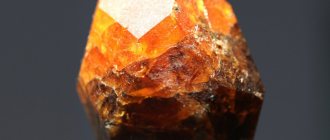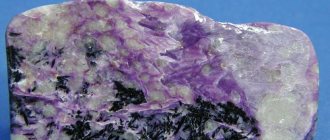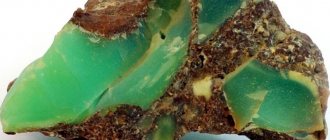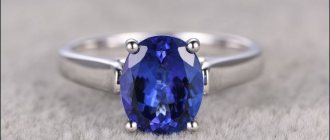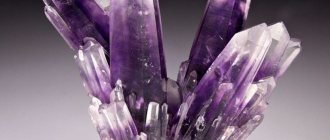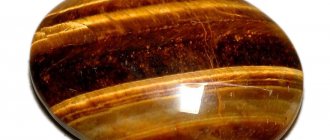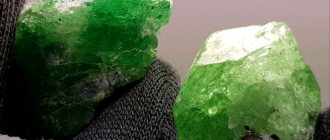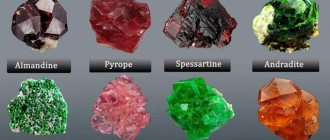This mineral is especially popular among professionals and amateurs. It is radioactive, but is necessary for the esoteric community. Any mineral collector is happy to have such a specimen in his collection. But finding allanite stone in regular sales is problematic.
allanite stone
Description and external signs
Allanite is a mineral discovered in 1810 by mineralogist Thomas Allan in the vastness of Greenland. Its name comes from the English word Allanite. In Russian there is a synonym for this word - Ortit (the ancient Greek “orthos” means “straight”).
Geologists use the following synonyms in relation to allanite:
- bagrationite;
- bodenite;
- muromontite;
- orthitis;
- tautolite;
- feather bed;
- cerepidote.
Allanite looks like this: crystals (if the stone has already been cut) or nuggets from light brown to black. There are thin white layers in the mineral - this is normal, since displacements often occur in the rock.
There are also unusual gradient samples: the crystals have a milky brown tint, and the main rock is dark brown or black.
Origin and location
Orthitis in the form of inclusions? as an accessory mineral, it is found mainly in acidic intrusive igneous rocks: granites, syenites, and is an important component of granitic pegmatites. pegmatites, sometimes gneisses, less often in crystalline schists.
Allanite was also found in effusive igneous rocks and in contact metasomatic deposits (among crystalline limestones).
Like most radioactive minerals, orthite is capable of undergoing changes to become an isotropic or nearly isotropic substance enriched in water. Under the name uralortite, it was described in pegmatite veins of the Ilmen Mountains in the form of irregularly shaped grains and crystals among reddish feldspar in association with zircon, sometimes corundum, black mica, etc. Acad. N.I. Koksharov described it under the name bagrationite in the form of crystals rich in facets.
Classification: colors, varieties, types
There are not many varieties of allanite as such, but several groups can be distinguished according to the following characteristics:
- color;
- content of additional elements.
Types of allanite by color
Allanite stone comes in a variety of colors:
- brown;
- resin;
- light brown;
- dark brown;
- black;
- yellow-brown.
The color of the mineral depends on the percentage of silicon in it.
Types of allanite according to the content of additional elements
The permanent elements in this mineral are calcium and silicon, but two additional ones can be added:
- beryllium (in this case the name of the stone changes to muromontite);
- magnesium (its content can reach 5%).
Magic properties
The radioactivity of allanite does not become an obstacle to its use by adherents of esotericism and magical practices.
On the contrary, a magic stone or amulets with it are considered a barrier to external influence, including otherworldly “guests”. That's why they are present in the offices of witches or sorcerers.
Ordinary people benefit from the magical properties of the stone:
- Allanite creates a protective barrier, but on a physical level. The amulet will help in business contacts with people who have a reputation as “energy vampires.” Or he will place an intractable interlocutor on the owner’s side.
- The inner voice and intuition are activated. The owner of the amulet will be able to catch and decipher signs of fate, including future events.
- A person’s self-esteem increases, self-confidence is added, and the magic of the stone imparts eloquence.
Hints received by the stone cannot be used to harm anyone. Allanite will attract all negativity to the owner.
Chemical composition and properties
The chemical molecular formula of allanite is (TR,Ca)2(Al,Fe)3[Si2O7][SiO4]O[O,OH], where TR is a free radical coupled with an additional element (beryllium or magnesium).
The following chemical reactions can be carried out with allanite:
- dissolution in hydrochloric acid to form silica;
- calcination with the formation of an acid-insoluble precipitate.
The unusual chemical composition allows us to observe the phenomenon of pleochronism in this mineral, that is, at different angles of inclination when exposed to sunlight, its color changes. For example, the red-brown color changes to golden brown or greenish brown.
Properties of allanite
The mineral contains impurities of rare earth elements. The rock formula is written as (Ca, Ce, La, Y)2(Al, Fe)3(SiO4)3(OH).
Properties of the gem:
- the fault surface is conchoidal;
- hardness - up to 6.5 points;
- pleochroism - shades of red, green, and golden colors appear;
- Radioactivity exists and accumulates.
For treatment, it is recommended to look at the gem. Light allanites help with eye fatigue, diseases of the nervous system, hypertension, dark ones - tone.
The gem is washed with water and cleansed with salt after each treatment session.
In magic they use a stone without a frame. It enhances the gift of persuasion and helps children over 16 years of age adapt to the team. The color of the mineral in talismans does not affect its esoteric properties.
Allanite is recommended to be worn:
- teachers;
- journalists;
- entrepreneurs;
- other people with public speaking activities.
The stone also enhances intuition, clairvoyance, and facilitates meditation. When combined with quartz, contact with spirit improves.
According to the horoscope, the mineral is ideally compatible with the energy of Pisces, Cancer, and Scorpio. It does not affect other zodiac signs, does not harm, and can be worn as jewelry.
Allanite is suitable for people with the names Adam, Yaroslav, Leo, Svyatoslav, Agata, Sofia, Karina, Zhanna.
Physical properties
The crystals have a greasy sheen, similar to metallic. Sometimes it can taste like glass.
Under the influence of certain environmental conditions, allanite can melt into a brown magnetic or glass ball.
The stone has average density and hardness (4-5 for each parameter).
Under the influence of high temperatures, the crystal lattice of allanite is destroyed, which leads to a loss of strength (this determines the result of the calcination process and the fact that long-term exposure to direct sunlight on allanite is prohibited).
Allanite has a huge number of fractures and irregularities.
Allanite deposits and their mining
The most common deposits of allanite are granite, gneiss and diorite, and in each rock the mineral has its own special natural form. So, somewhere it can be small isometric inclusions of stone, and somewhere it can be sharp needle-shaped crystals up to half a meter in length.
The largest allanite deposits are located in the following areas:
- Arendal in Norway;
- Stockholm and Falun in Sweden;
- Vaarala in Finland;
- California and Virginia in the USA;
- Middle Alps in Italy;
- North Karelia, Southern Urals, Baikal region and Ilmensky Nature Reserve in Russia.
Allanite is mined in the following way: first, granite, diorite or gneiss is drilled. Next, this mineral is isolated from the rock, and studies are carried out to determine the content of additional elements. Next, the allanite is purified from impurities, and the resulting product is a beautiful nugget with amazing properties.
Place of Birth
Orthite occurs in crystals, most often in silicate rocks, being a complement to granites, gneisses, and occasionally volcanic rocks. There are intergrowths of allanite with titanite, zircon, feldspar, and quartz. Allanite looks unusual surrounded by crystals of a related mineral - epidote. Such finds resemble stone inflorescences in appearance.
The occurrence of allanite is associated with deposits of gneiss, granite or diorite rocks. Each deposit is characterized by its own special form of mined stone - somewhere orthite is found in the form of needle-shaped long crystals, while in other rocks the nugget is contained in small inclusions.
The most significant places for orthite mining are considered to be the following areas:
- Sweden.
- USA.
- Finland.
- Russia.
- Norway.
- Island of Madagascar.
- Canada.
- Italy.
Field development is also underway in France and Ukraine. Russian deposits are concentrated in the Ilmensky Nature Reserve, in the north of Karelia, the south of the Urals, and also in the Baikal region. Less rich deposits are concentrated in another two dozen countries around the world.
In order to obtain pure orthite, you must first drill into the rock that bears it - granite, gneiss or diorite. Afterwards, the mineral is separated from the rock and the stone is checked for the presence of various elements. The final stage of extraction is the purification of allanite from impurities.
Mythology: the history of the magic stone
According to legend, an ancient sorcerer accidentally found allanite in the cache of his ancestor. The stone was incredibly beautiful: its black edges let the sun's rays through, changing the color of the mineral to a lighter one. It was cut into the shape of a regular volumetric hexagon.
According to the laws of magic, you should not touch relics that do not belong to you. However, the sorcerer disobeyed and took it. At that moment, it was as if Pandora’s box had been opened - he established a stable connection with the other world and was its “guide.”
The sorcerer acquired the gift of clairvoyance, he began to see and feel what others did not feel, but one day he almost became a victim of evil spirits. The white magician was able to free him from this painful addiction, at the same time expelling everything dark from the stone.
Since then, allanite began to be considered a magical stone that establishes a connection with supernatural forces.
Allanite was a favorite stone among alchemists, who believed that it would help them obtain the philosopher's stone.
Thus, the famous alchemists Nicolas Flamel and Paracelsus often mentioned allanite in their treatises as “a special stone endowed with the property of establishing contact with dark forces.” Although they did not obtain the philosopher's stone, they left an unusual description of this material.
Where is allanite used?
The goals of allanite are determined by the following circumstances:
- The mineral is radioactive.
- it is a source of rare earth elements.
- Esotericists and sorcerers will appreciate its properties.
Allanite is not in demand in the jewelry industry due to fear of radiation and poor conditions - the mineral does not look very presentable.
But the point is different.
The main purpose of the stone is to serve as a raw material for the production of rare earth elements. Thorium and other components are extracted from it, the price of which is prohibitively high on the world market.
Naturally, allanite does not go on public sale (or very rarely). It was not possible to find such copies even on specialized Russian Internet sites.
Therefore, meeting every allanite stone means good luck for a person. Ore collectors and sorcerers “fight” for such samples. The first one is those who want to add to the collection. The second is to understand the significance of the allanite stone as an “organizer” of contacts with the other world.
Ring with allanite
There is confusion among jewelry lovers. The search for “allanite jewelry” provides information about alpanite, an artificial stone.
Application area
Allanite is used in the following areas:
- jewelry - unusual jewelry of incredible beauty is created, in which the mineral is subjected to high-quality cutting;
- antique - connoisseurs of everything unusual often order vases and other decorative items made of allanite, this is due to its extraordinary beauty and the versatility of its shades;
- household - expensive kitchen panels are made that do not have any electrical conductivity.
The scope of allanite is extremely narrow, because this stone is classified as rare.
Compatibility by zodiac sign
Allanite is a stone with a mysterious history, which is credited with magical properties and a connection with mysticism and the other world. That is why it is suitable for the water signs of the zodiac: Pisces, Cancer and Scorpio.
Fish
Receptive and vulnerable Pisces form an ideal union with this stone. By transferring its magical energy to them, allanite helps creative individuals find their place in life and satisfy their interest in everything mystical.
Cancers
Generous, reliable and romantic Cancers simply need this stone. Multifaceted allanite helps them to withstand life's difficulties and maintain a bright soul even in the most difficult conditions.
Scorpion
Passionate, emotional and persistent, Scorpio often wastes his vitality, giving all of himself to those close to him. In this case, emotional devastation occurs. Rich allanite helps this zodiac sign replenish vitality and find balance, establish harmony.
Medicinal properties
Allanite has the following medicinal properties:
- relieves headaches and migraines,
- help you fall asleep faster and get rid of insomnia,
- Works as a sedative, giving peace of mind.
Homeopathic doctors and adherents of traditional medicine often prescribe patients to lie in the sun with allanite on the chest or back. They believe that by changing its color under the influence of direct sunlight, allanite draws all the bad things onto itself, as if reversing the course of the disease.
Patients who have tried this procedure note that the disease actually goes away without leaving a trace.
Magic properties
Allanite has the following magical properties:
- an energy exchange occurs - the mineral draws out all the bad things and gives its positive energy in return;
- the “third eye” opens - a person wearing allanite feels the highest degree of knowledge, he has excellent intuition;
- works as an amulet - it scares away bad entities and guarantees its protection.
At the “workplace” of fortune tellers and clairvoyants, you can often find an allanite amulet hanging on the mirror or neck of their owners. This is due to the fact that their sphere of activity involves contact with the other world. And as you know, any such activity has its risks, and ignoring them means taking a big risk. Allanite protects influences from evil spirits, guaranteeing a favorable outcome of any rituals.
Allanite jewelry
This mineral makes excellent earrings or rings. Also, some jewelry companies produce limited collections, where there are special bracelets consisting only of faceted allanites in the shape of a ball.
In addition, you can make beautiful jewelry from this mineral yourself. All you have to do is drill a hole in it and insert a black braided cord into it. Stylish decoration is ready!
Household use of allanite
Allanite is a dielectric, that is, it does not conduct electric current. This can be used in everyday life, for example, to make stands for electrical equipment, any parts or tiles for laying from this mineral.
However, using allanite in everyday life is expensive, so practical applications are extremely rare, because there are a huge number of dielectric minerals that can provide cheap production and a similar effect.
Medicinal properties
Despite all its originality, allanite is not as interesting for lithotherapists as it is for scientists or esotericists. The only procedure in which this gem is useful is contemplation. It is believed that orthitis relieves tension in the eye muscles and also has a calming effect on the nervous system.
For such purposes, only light-colored specimens, preferably yellowish or greenish, are suitable. Dark brown crystals bring blood pressure to normal levels. There is an opinion that orthitis helps weather-dependent people tolerate natural inconstancy more easily, relieves headaches, and helps them fall asleep quickly.
Allanite as a patron of the name
Esotericists do not highlight the special attachment of the essence of allanite to any names, however, modern theorists relate it to the following names:
- female: Agata, Sophia, Zhanna, Karina, Inessa;
- male: Adam, Yaroslav, Svyatoslav, Leo, Christian.
This variety of names is due to the magical power of allanite - it opens the “third eye”, gives amazing intuition and allows you to experience the highest degree of knowledge.
The best way to associate a stone with a name is to wear an amulet or talisman made from it.
How to wear jewelry and store a stone
The specific origin of the stone requires greater awareness on the part of the owner when interacting with it.
The use of allanite requires compliance with the general rules for handling minerals, as well as taking into account the characteristics of the stone:
- Jewelry with stones should not be dropped or hit.
- Prolonged exposure to the sun is contraindicated for the mineral: exposure to direct sunlight increases radioactivity.
- Store allanite specimens or jewelry in a locked or preferably sealed place. A good place is a box or drawer, lined with soft fabric on the inside and tightly closed.
You can wear jewelry or use allanite only occasionally (for example, for medical procedures). They need to be removed at night.
It is not enough to cure stones that are used as amulets or talismans: allanites need energetic cleansing. To do this, they are regularly washed with running water, plus they are “buried” with salt weekly for several hours or overnight.
Combinations with other stones
Allanite combines best with other dark-colored stones:
- Precious stones: diamond (an allotropic modification of black carbon is called carbonado), sapphire, black spinel, pearl, black opal;
- Semi-precious stones: black quartz;
- Decorative and ornamental stones: onyx, agate, obsidian, jasper, hematite, dark amber.
They can be combined in jewelry or your own collections.
It will be very beautiful if you make a collection of allanite and other similar stones.
How to distinguish from a fake?
True allanite will never be the perfect shape, even if subjected to the most careful cutting. Nature has it in such a way that its rock contains a huge number of fractures, and polishing everything to the state of an ideal crystal means cutting down a lot of stone, which is extremely unprofitable for anyone.
Allanite sold at retail will not be cheap or large in size. The average size of a real stone, which can be purchased in a special shop, is 5-6 centimeters in length and 3 in width.
If you purchase goods from geologists or mineralogists, the dimensions may differ. It all depends on the situation.
Stone care
In order for allanite to retain its aesthetic appearance for as long as possible and amaze the imagination with its richness of facets, it is necessary to regularly wipe it with a solution of hydrogen peroxide. This technique creates the effect of a polishing fluid: the stone shines and less dust settles on it.
To observe the phenomenon of a crystal changing color depending on the angle of inclination, it is necessary to expose it to sunlight. However, this often cannot be done, because the bonds between the atoms of the elements that make up it may be destroyed.
You also need to dip the allanite in an aqueous solution of silver once a month to clean it of any deposits that have formed and restore its original shine. The main thing in this matter is not to overdo it, otherwise the crystal lattice of the mineral may begin to collapse, and the stone itself will deteriorate.
Allanite as a talisman is an opportunity for the owner to take advantage of the healing and magical powers of the crystal.
Varieties of allanite
Mineralogists classify allanite based on the presence of impurities and color.
Impurities
Orthites are classified into types depending on the predominant mixture of rare earth elements in the overall composition:
- allanite-Ce—samples with a mixture of cerium;
- allanite-La - lanthanum;
- allanite-Y—orthites with yttrium;
- allanite-Nd - with neodymium.
The first type of mineral is the most common. The latter is the most recent, opened in 2011.
Coloristics
Orthitis is identified by a combination of dark colors.
His description is not very diverse:
- brown stones - light, dark, with yellow;
- black - monochrome or grayish.
In nature, dull allanites of these colors and shades are almost always found.
